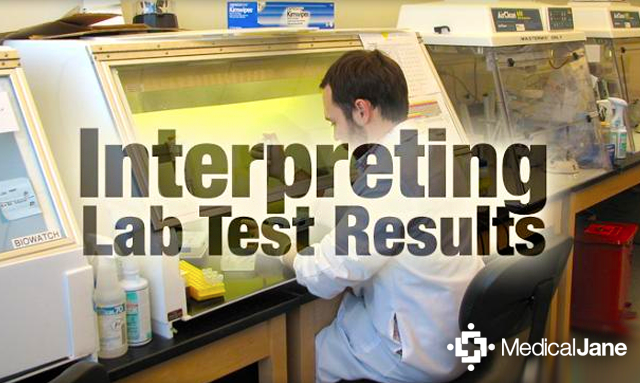
Cannabis Test Results: What You Should Know
Cannabis Test Results Help Make Informed Patients
It’s no secret that we here at Medical Jane are huge proponents of lab testing cannabis. It allows patients to be confident in their collective, knowing there are no contaminants in the flowers, concentrates, or edibles before they donate. Personally, I won’t frequent a collective unless they submit samples for testing at places like CannLabs (Denver) or The Werc Shop (Los Angeles).
Not only does cannabis testing ensure the cleanliness of a given sample, but it helps paint a picture of what effects to expect. In order for these numbers to be useful, however, patients must know what the numbers represent. The idea that the highest percentage of tetrahydrocannabinol (THC) equates to the “best” choice is a sentiment of the past. It’s becoming clear that finding the right balance of cannabinoids for each individual is key.
How To Interpret Cannabis Lab Testing Results
Despite the increased popularity of cannabis testing, many patients are unsure about what the results mean. It can be especially confusing for a new patient to determine which cannabinoid profile will best suit their needs. When you look at the products available at a collective, you see that the cannabinoid profiles can be vastly different.
If 1g of cannabis flower is tested at 12.5% THC and 12.5% CBD, then it contains 125mg of THC and 125mg of CBD in the sample.
It makes it difficult to find a good starting point when you have no clue what you need. Overall, I would say the ratio of cannabinoids is the most important thing to look at. Its widely believed that a 1:1 ratio between cannabidiol(CBD) and THC would be ideal. With that being said, the other cannabinoids, like tetrahydrocannabivarin (THCV) and cannabichromene(CBC), have distinct effects to be considered as well.
When used correctly, the percentages can serve as a reference point to determine a patient’s preferred dosage of cannabinoids. Consider that 1g is equal to 1,000 mg. Therefore, 1g of flower that tests at 12.5% THC, and 12.5% CBD, contains 125 mg of each cannabinoid.
When provided with a full cannabinoid & terpene profile of a strain, keeping in mind that terpenes also have their own medicinal benefits, a patient can better determine which strain profile would be most effective for suiting their particular needs.
Cannabis Test Results Should Be Displayed More Simply
The use of percentages certainly serves a purpose, but cannabinoid profiles should be displayed more simply for patients. Collectives should take the extra step to state the amount of cannabinoids and terpenes in milligrams (mg) on every label as well. That way much of a patient’s confusion about the “potency” of a product would be eliminated.
The majority of a cannabis flower’s weight is plant matter, which has relatively no benefit to patients.
The popularity of cannabis concentrates, like BHO (shatter, wax, sap, etc.), has added bit mroe confusion for the inexperienced patient. These concentrates routinely are lab tested at 60%, 70%, and even 80% THC. Obviously, that is a much higher percentage than you will see in any sample of flowers. That’s because it is based on the overall weight of the sample, and pure concentrates are only cannabinoids and terpenes.
1g of flower and 1g of concentrate will have vastly different levels of cannabinoids, even if they come from the same plant. As of now, it’s left up to patients to calculate the cannabinoid levels of each product for themselves; this puts an unnecessary burden on them. It should always be perfectly clear what patients are receiving when making a donation; listing the exact weight of each cannabinoid per gram would eliminate any confusion.
Scientific studies involving smoked and vaporized cannabis have already specify exact cannabinoid dosages in milligrams (ex. 10mg joint). Why shouldn’t the medical cannabis community expect the same amount of information if it’s possible?
Simpler Cannabis Test Results Would Aid In Regulation
Clearly labeling the amount of cannabinoids in a given sample would be a great tool to help regulate the medical cannabis industry. This is especially important since Eric Holder, US Attorney General, recently announced that the federal government will no longer harass patients and caregivers in states with appropriate regulations (of course it remains to be seen if that’s true.)
Regardless of the legal implications, the medical cannabis community may benefit if we begin to treat cannabinoids as nutrients. The FDA lists nutritional facts with an exact weight in order to let consumers know exactly what they are ingesting with each serving. This also allows them to determine a recommended amount of each nutrient; cannabis could enjoy the same luxury one day.
50mg THC is much more meaningful to patients than “single dose” when considering how much they need.
In fact, many medicated edible makers have already adopted the practice of labeling their products with the exact cannabinoid content. Companies like Dr. Robert’s Bakery, The Venice Cookie Co., and Toffee Turtles clearly state the amount of THC in each of their products. Because of this, patients are able to easily determine the proper dosage for their individual needs and adjust their medicating habits accordingly.
Labeling all dried cannabis, similar to edibles, with a precise amount of each cannabinoid per gram would be a great help to patients. By monitoring their intake, each patient would be able to easily identify an effective dose for their condition(s). If it’s made clear that there are 125 mg THC and 125 mg CBD in every gram of flower, intake becomes easy to monitor.
Cannabis lab testing is only helpful when used correctly. New ways of displaying test results would eliminate the guess work and help patients be more informed when choosing their medicine. A simpler display would make it easier for patients to find their ideal dose. I’ve found 100 mg daily to be effective for my anxiety and insomnia.